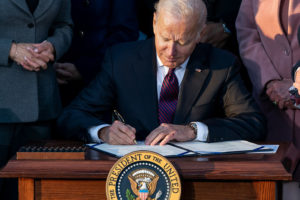
President Joe Biden signing the Infrastructure Investment and Jobs Act, Monday, November 15, 2021, on the South Lawn of the White House. (Official White House Photo by Cameron Smith)
This past Tuesday in New Hampshire, Joe Biden offered an optimistic assessment of the possibilities for his infrastructure spending. But, as the WSJ’s James Freeman, notes, “The president’s assessment of the country generally was rather bleak.”
From President Biden:
Take a look at what’s happened over the last 20 years. The backbone of this nation has been hollowed out: hardworking, middle-class folks.
Biden: 8 Years as VP, 1 Year as President, Perpetual as U.S. Senator
Quite a remarkable comment from a man who served as “vice president for eight of those 20 years, president for nearly one and a senior U.S. senator for most of the rest,” Mr. Freeman concludes.
Biden continued:
The state has already spent a quarter of a million dollars on “Band-Aid” repairs on this bridge alone.
And right now, there are 215 bridges in your state — 215 bridges deemed structurally unsafe in New Hampshire alone.
Well if that didn’t fire up the crowd to cheer Mr. Biden’s latest trillion-dollar spending plan, asks Mr. Freemman, what on earth would?
Speaking of bumpy rides, Mr. Freeman continues:
(T)he great patron of the Pemigewasset did not enjoy an uneventful journey to the river bank as a smattering of protesters scored the President for rising inflation. A few held signs saying, “Let’s Go Brandon,” a popular euphemism for a crude insult of the president.
Why BBB Will Fail
Clifford Winston of the Brookings Institution discusses Biden’s Build Back Better bill in a Barron’s op-ed:
Unfortunately, the infrastructure component of his plan will fail to significantly improve the nation’s roads, bridges, and the like because it ignores the vast inefficiencies in current transportation policy that greatly reduce benefits from infrastructure spending.
Let me take you on the journey of a dollar of government spending intended to improve, for example, travel conditions on a highway. This dollar will have a long, perilous trip and encounter many dangers enroute that will divert it from its correct destination and take large, wasteful chunks out of it. By the time it reaches the wrong destination, it will fund much less than a dollar’s worth of highway improvements. The dangers it encounters include inefficient road pricing and investment policy, inflated input and project costs, misallocation of highway revenues, and the slow adoption of technological innovations.
If you’re willing to fight for Main Street America, click here to sign up for the Richardcyoung.com free weekly email.




